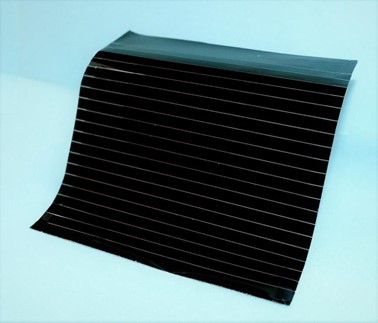Kaneka to Accelerate Development to Social Implementation of High-Performance Perovskite Solar Cells via the NEDO Green Innovation Fund
Kaneka Corporation
March 16, 2022
Kaneka Corporation (Headquarters: Minato-ku, Tokyo; President: Minoru Tanaka) has been adopted by the New Energy and Industrial Technology Development Organization (NEDO) acquiring subsidies for Next-Generation Solar Cell Development Project under the Green Innovation Fund*1, and will accelerate the development towards the practical application of its high-performance perovskite solar cells.March 16, 2022
In recent years, perovskite solar cells*2 have gained global attention as next-generation solar cells which enable both high conversion efficiencies and low production costs. Likewise in Japan, who is seeking to achieve carbon neutrality by 2050, it is expected that the light weight and flexibility of perovskite solar cells will enable themselves to be installed in locations where existing technologies find it challenging.
Using an in-house designed polyimide substrate and drawing on its expertise in the mass production of thin-film silicon solar cells*3, Kaneka has been developing ultra-thin perovskite solar cells that are approximately 10µm thick—the thinnest in the world*4—and has already achieved a world-class conversion efficiency*5 of 20%*6 for film-type perovskite solar cells. Aiming at the social implementation of such innovative perovskite solar cells, we will promote “the practical development of high-performance perovskite solar cells utilizing the ultra-thin and size-flexible features”.
On March 31, 2021, Kaneka announced its support for the recommendations of the Task Force on Climate-related Financial Disclosures (TCFD); the company has identified its solar cell business as an area of importance in its efforts to realize carbon neutrality by 2050.
*1. The Green Innovation Fund was established by the Ministry of Economy, Trade and Industry (METI) on December 25, 2020, as part of its Green Growth Strategy Through Achieving Carbon Neutrality in 2050. The Fund provides continued support over a period of 10 years for the research and development, demonstration, and social implementation of new technologies; to be eligible for funding, companies must commit to ambitious and concrete public-private goals as long-term management issues. METI has designated next-generation solar cells as a priority field in which growth can be expected.
*2. “Perovskite solar cells” are solar cells that use perovskites (materials with a specific type of crystalline structure) in their light-absorption layer.
*3. “Thin-film silicon solar cells” use thin-films of silicon in their light-absorption layers. Kaneka realized thin-film silicon solar cells with a capacity of approximately 120MW every year; using the mass-production technologies it has cultivated via the production of its thin-film silicon solar cells, the company is currently engaged in the production of heterojunction crystalline Si solar cells.
*4. According to research carried out by Kaneka.
*5. “Conversion efficiency” is an important performance indicator for solar cells, and refers to the proportion of the electrical energy converted from solar energy to the solar energy.
*6. The conversion efficiency of 20% is based on the conversion efficiency measurements carried out by Japan Electrical Safety & Environment Technology Laboratories (JET), in line with the international IEC 60904 standard. Kaneka’s solar cell achieved a cell conversion efficiency of 19.8% for a specified measured surface area of 0.1cm2

